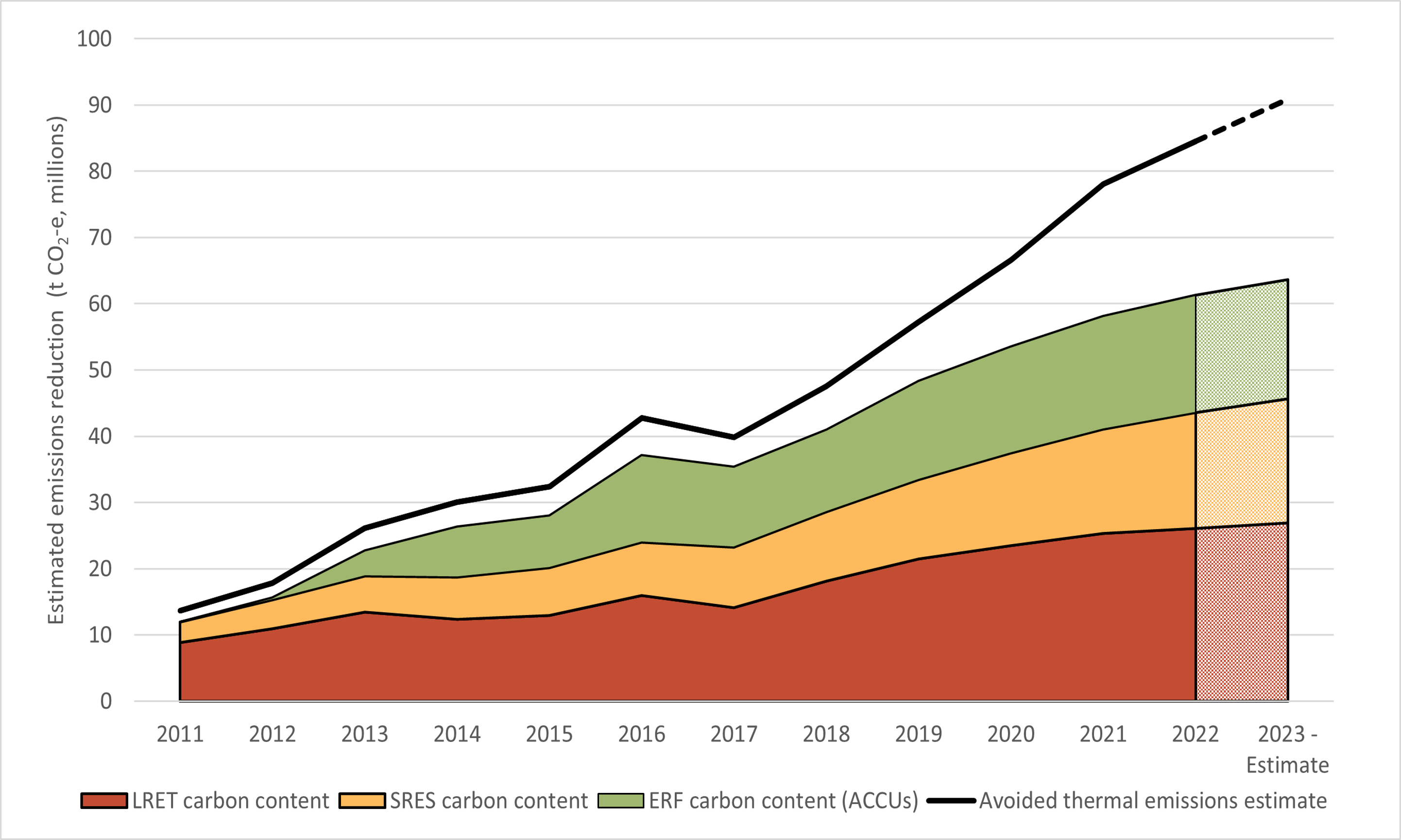In 2022, we administered schemes that reduced emissions by 61.3 million tonnes of carbon dioxide equivalent (CO2-e). This is an improvement on 2021 where the CER schemes reduced emissions by 58.1 million CO2-e.
In 2022, the Emissions Reduction Fund (ERF) issued equivalent to 17.7 million tonnes of CO2-e emissions abatement. This is a 4% increase compared to 2021.
The Renewable Energy Target (RET) contributed 43.6 million tonnes CO2-e of emissions reduction in 2022, a 6% increase from 2021. Of which, 26.1 million tonnes of CO2-e was from the Large-scale Renewable Energy Target (LRET) and 17.5 million tonnes CO2-e was from the Small-scale Renewable Energy Scheme (SRES). As discussed in the September 2021 QCMR, it is expected that renewables captured under the RET will continue to reduce emissions but at a reduced rate as the emissions intensity of the grid declines.
The RET added 8.6 million MWh of renewable energy to the grid in 2022. The emissions reduction estimate for 2022 was based on the average emissions intensity of the grid. This fell to 0.61 tonnes CO2-e per MWh compared to 0.65 tonnes CO2-e per MWh in 2021. This modest difference is due to the rapidly declining emissions intensity of the grid as uptake of renewable energy continues to increase.
We estimate scheme-based emissions reductions in 2023 to be 63.7 million tonnes of CO2-e. This is an anticipated increase of 4% compared to 2022 (see Figure 4.1).
We have incorporated National Electricity Market (NEM) and South West Interconnected System (SWIS) data when calculating our estimates. This provides a better estimate for the national emissions intensity factors for 2021 and 2022. A linear forecast has been used to estimate the 2023 emissions intensity factor for the emissions reductions from the RET.
Emissions reductions using thermal displacement
When using the thermal generation displacement approach, we estimate emissions reductions in 2022 to be 84.5 million tonnes of CO2-e. Every additional MWh of additional renewable generation displaces a MWh of either coal or gas generation. This includes renewables incentivised through the LRET and SRES schemes. The September 2021 QCMR provides a methodological overview of the emissions reduction estimates using average emissions intensity and emissions intensity of displaced thermal generation. The estimate of emissions reductions using thermal displacement is higher because electricity generated from displaced thermal fuel sources (primarily coal and gas) has a higher emissions intensity than electricity from the current generation mix in the NEM and SWIS. We estimate 0.93 tonnes CO2-e per MWh for thermal generation versus 0.61 tonnes CO2-e per MWh for the grid.
We project the 2023 estimate using the thermal displacement approach will be 90.8 million tonnes of CO2-e.
Estimated emissions reduction from ERF and RET
2011 to 2023 Note: This figure is not interactive.
Description
This graph shows the estimated emissions reduction from the ERF, SRES, and LRET.
Small print
Annual values used in this graph can be slightly different from those reported in previous Quarterly Carbon Market reports for some years due to updated generation, scheme information and minor revisions to the methodology.
Abatement estimation methodology
The carbon content estimates calculate an implicit 'carbon content' for LGCs and STCs using the annual average emissions intensity of the National Electricity market (data sourced from the Department of Climate Change, Energy, the Environment and Water: National Greenhouse Accounts Factors: 2022 report, and the OpenNEM). This convention provides an equivalence between 1 MWh of large or small-scale generation and 1 tonne of CO2-e of emissions reduction. In a 100% renewable grid, the emissions reduction delivered by 1 MWh of large or small-scale generation would be zero, because there would be no further emissions to reduce. The 2022 emissions intensity factor used in the calculation is a projection based on the annual average emissions intensity of the National Electricity Market (NEM) and South West Interconnected System (SWIS) over the last five years.
The avoided emissions estimate assumes that LRET and SRES generation displace thermal generation. Under this approach, emissions reduction from the LRET and SRES is proportional to the weighted average emissions intensity of thermal generation in the NEM and SWIS. Each MWh of renewable electricity is assumed to displace 1 MWh of thermal generation, resulting in a higher emissions reduction estimates. In this calculation the 2022 thermal emissions intensity factor is used.
Both the carbon content and avoided emissions estimates include an ERF component which assumes 1 ACCU represents 1 tonne of CO2
Only the estimated generation for the year in which a small-scale renewable energy system is installed is accounted for in the estimation methods.
| 2022 Emissions reduction by scheme (million tonnes CO2-e) | 'Carbon content'' estimate (conservative approach) | 'Avoided emissions' estimate (thermal displacement) |
|---|---|---|
| LRET | 26 | 40.2 |
| SRES | 17.5 | 26.6 |
| ERF | 17.7 | 17.7 |
| Total | 61.3 | 84.5 |